HRM Practices: Workforce Planning, Employee Relations & Legislation
VerifiedAdded on 2024/04/26
|23
|3921
|354
Report
AI Summary
This report provides an analysis of Human Resource Management (HRM) practices, focusing on workforce planning, recruitment and selection approaches, and employee relations. Using H&M as a case study, the report explains the purpose and functions of HRM in workforce planning, evaluates the strengths and weaknesses of different recruitment methods (internal and external), and assesses how HRM functions can provide talent and skills to meet business objectives. It further explores the benefits of HRM practices for both employers and employees, examines various methods used in HRM, and evaluates the effectiveness of these practices in raising organizational profit and productivity. The report also analyzes key aspects of employee relations management, employment legislation, and their influence on HRM decision-making, providing specific examples and a rationale for the application of HRM practices in a work-related context. Desklib provides access to this and other solved assignments.

HRM
1
1
Paraphrase This Document
Need a fresh take? Get an instant paraphrase of this document with our AI Paraphraser

Table of Contents
Introduction......................................................................................................................................4
Task 1...............................................................................................................................................5
P1. Explain the purpose and functions of HRM applicable to the workforce planning and
resourcing an organisation...........................................................................................................5
M1.Assess how the functions of HRM can provide talent and skills appropriate to fulfil
business objectives.......................................................................................................................6
D1 critically evaluate the strengths and weaknesses of different approaches to recruitment and
selection, supported by specific examples...................................................................................7
P2 Explain the strengths and weaknesses of different approaches to recruitment and selection 8
M2 Evaluate the strengths and weaknesses of different approaches to recruitment and selection
...................................................................................................................................................10
D2.Critically evaluate HRM practices and application within an organisational context using a
range of specific examples.........................................................................................................11
Task 2.............................................................................................................................................12
P3. Explain the benefits of different HRM practices within an organisation for both the
employer and employee.............................................................................................................12
M3 Explore the different methods used in HRM practices providing specific examples to
support evaluation within an organisational context.................................................................13
P4. Evaluate the effectiveness of different HRM practices in terms of raising organisational
profit and productivity...............................................................................................................14
M4 Evaluate the key aspects of employees relations management and employment legislation
that affect HRM decision in an organisational context.............................................................15
2
Introduction......................................................................................................................................4
Task 1...............................................................................................................................................5
P1. Explain the purpose and functions of HRM applicable to the workforce planning and
resourcing an organisation...........................................................................................................5
M1.Assess how the functions of HRM can provide talent and skills appropriate to fulfil
business objectives.......................................................................................................................6
D1 critically evaluate the strengths and weaknesses of different approaches to recruitment and
selection, supported by specific examples...................................................................................7
P2 Explain the strengths and weaknesses of different approaches to recruitment and selection 8
M2 Evaluate the strengths and weaknesses of different approaches to recruitment and selection
...................................................................................................................................................10
D2.Critically evaluate HRM practices and application within an organisational context using a
range of specific examples.........................................................................................................11
Task 2.............................................................................................................................................12
P3. Explain the benefits of different HRM practices within an organisation for both the
employer and employee.............................................................................................................12
M3 Explore the different methods used in HRM practices providing specific examples to
support evaluation within an organisational context.................................................................13
P4. Evaluate the effectiveness of different HRM practices in terms of raising organisational
profit and productivity...............................................................................................................14
M4 Evaluate the key aspects of employees relations management and employment legislation
that affect HRM decision in an organisational context.............................................................15
2
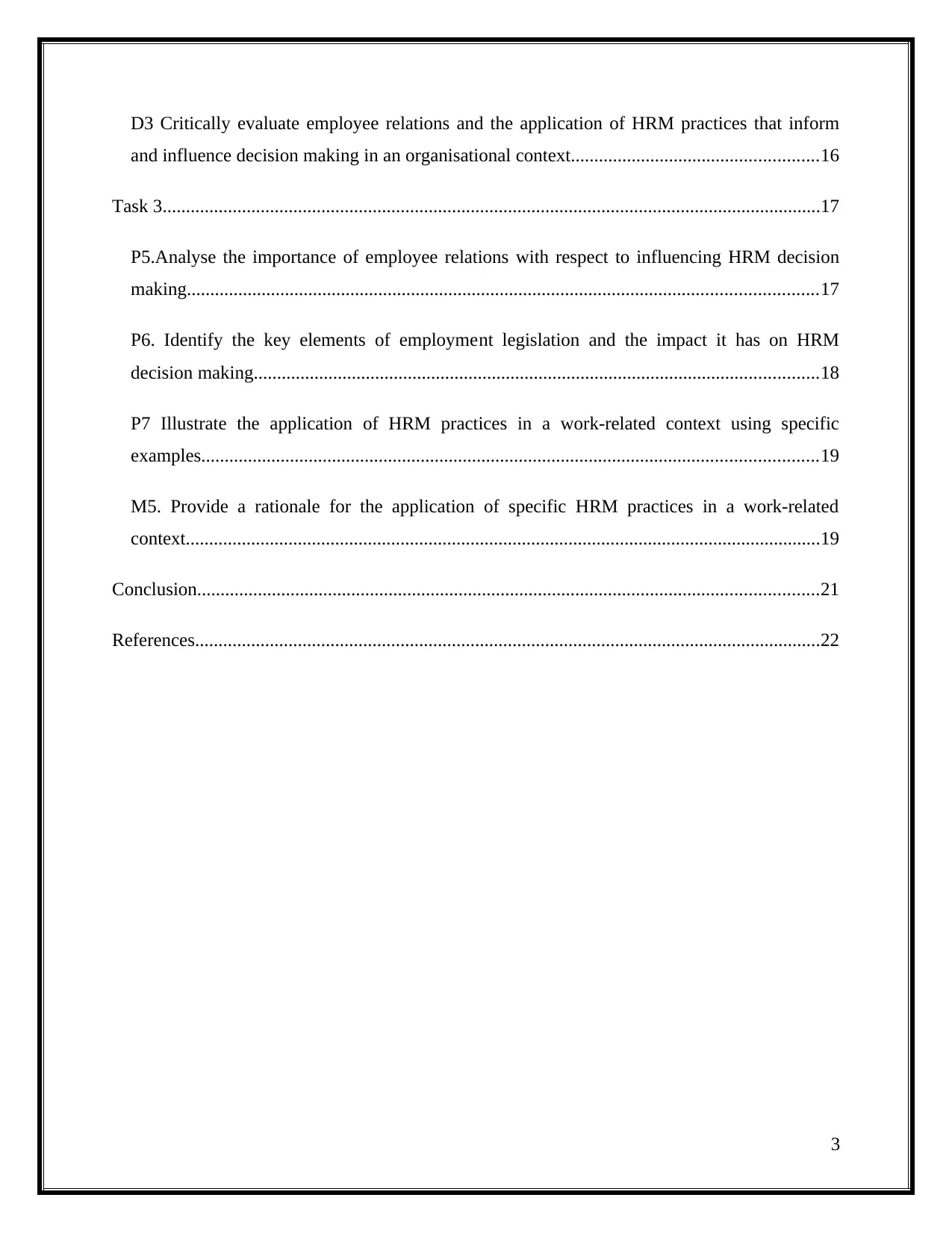
D3 Critically evaluate employee relations and the application of HRM practices that inform
and influence decision making in an organisational context.....................................................16
Task 3.............................................................................................................................................17
P5.Analyse the importance of employee relations with respect to influencing HRM decision
making.......................................................................................................................................17
P6. Identify the key elements of employment legislation and the impact it has on HRM
decision making.........................................................................................................................18
P7 Illustrate the application of HRM practices in a work-related context using specific
examples....................................................................................................................................19
M5. Provide a rationale for the application of specific HRM practices in a work-related
context........................................................................................................................................19
Conclusion.....................................................................................................................................21
References......................................................................................................................................22
3
and influence decision making in an organisational context.....................................................16
Task 3.............................................................................................................................................17
P5.Analyse the importance of employee relations with respect to influencing HRM decision
making.......................................................................................................................................17
P6. Identify the key elements of employment legislation and the impact it has on HRM
decision making.........................................................................................................................18
P7 Illustrate the application of HRM practices in a work-related context using specific
examples....................................................................................................................................19
M5. Provide a rationale for the application of specific HRM practices in a work-related
context........................................................................................................................................19
Conclusion.....................................................................................................................................21
References......................................................................................................................................22
3
⊘ This is a preview!⊘
Do you want full access?
Subscribe today to unlock all pages.

Trusted by 1+ million students worldwide

Introduction
This report is prepared to analyse the concepts of the practices of the Human Resource
Management. The case study of H & M is taken into consideration to explain the purposes and
the functions which are applied in the case of workforce planning. The functions are evaluated
along with the several approaches used in the recruitment and selection. The specific application
of the HRM practices are also provided in regards to the H & M. The effective relations
maintained with the employees helps in the enhancing the size and productivity of the
organisation which is provided in this report. The effective analyses of the employment
legislation that are applicable to the employees are also provided in this report to develop the
effective understanding.
4
This report is prepared to analyse the concepts of the practices of the Human Resource
Management. The case study of H & M is taken into consideration to explain the purposes and
the functions which are applied in the case of workforce planning. The functions are evaluated
along with the several approaches used in the recruitment and selection. The specific application
of the HRM practices are also provided in regards to the H & M. The effective relations
maintained with the employees helps in the enhancing the size and productivity of the
organisation which is provided in this report. The effective analyses of the employment
legislation that are applicable to the employees are also provided in this report to develop the
effective understanding.
4
Paraphrase This Document
Need a fresh take? Get an instant paraphrase of this document with our AI Paraphraser
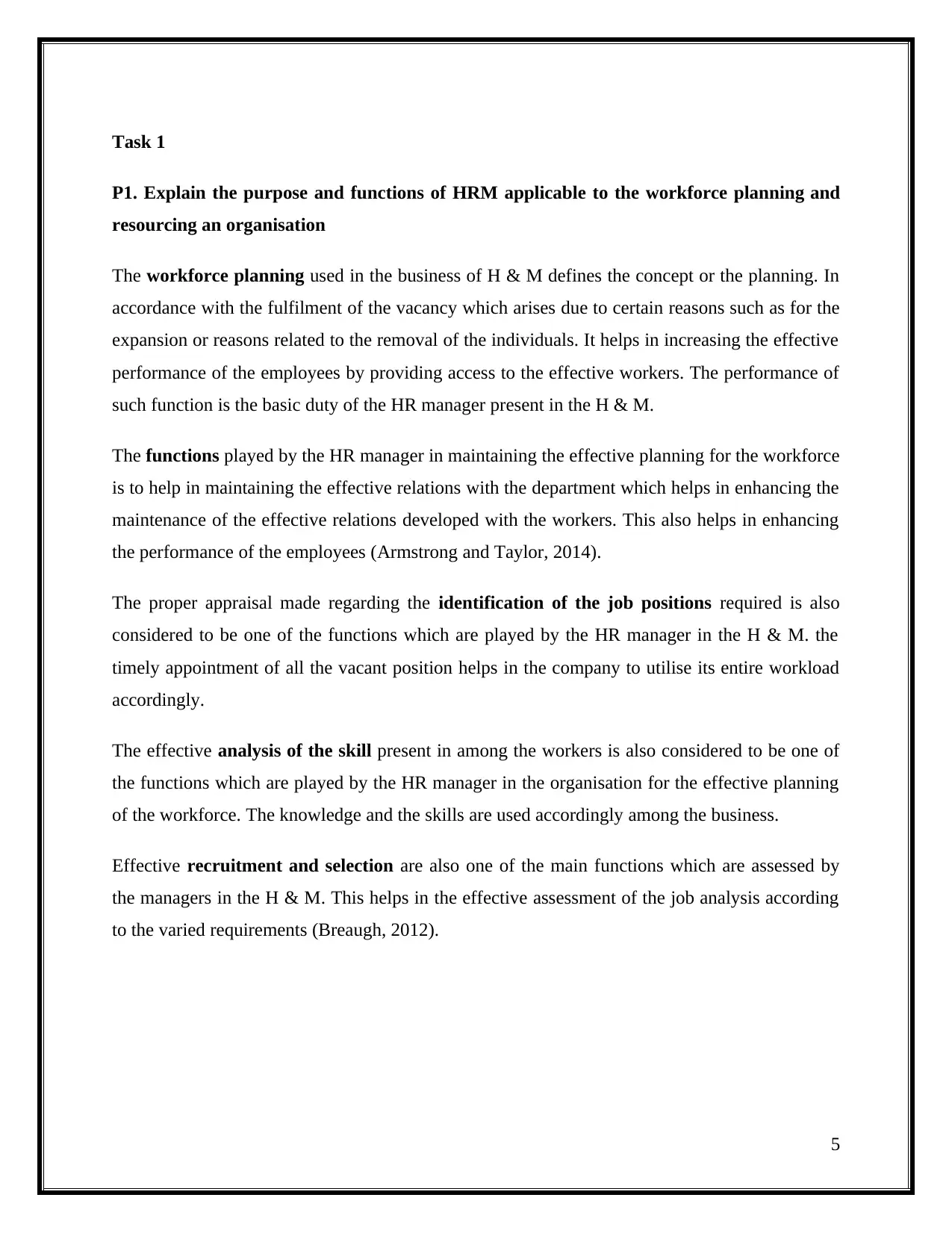
Task 1
P1. Explain the purpose and functions of HRM applicable to the workforce planning and
resourcing an organisation
The workforce planning used in the business of H & M defines the concept or the planning. In
accordance with the fulfilment of the vacancy which arises due to certain reasons such as for the
expansion or reasons related to the removal of the individuals. It helps in increasing the effective
performance of the employees by providing access to the effective workers. The performance of
such function is the basic duty of the HR manager present in the H & M.
The functions played by the HR manager in maintaining the effective planning for the workforce
is to help in maintaining the effective relations with the department which helps in enhancing the
maintenance of the effective relations developed with the workers. This also helps in enhancing
the performance of the employees (Armstrong and Taylor, 2014).
The proper appraisal made regarding the identification of the job positions required is also
considered to be one of the functions which are played by the HR manager in the H & M. the
timely appointment of all the vacant position helps in the company to utilise its entire workload
accordingly.
The effective analysis of the skill present in among the workers is also considered to be one of
the functions which are played by the HR manager in the organisation for the effective planning
of the workforce. The knowledge and the skills are used accordingly among the business.
Effective recruitment and selection are also one of the main functions which are assessed by
the managers in the H & M. This helps in the effective assessment of the job analysis according
to the varied requirements (Breaugh, 2012).
5
P1. Explain the purpose and functions of HRM applicable to the workforce planning and
resourcing an organisation
The workforce planning used in the business of H & M defines the concept or the planning. In
accordance with the fulfilment of the vacancy which arises due to certain reasons such as for the
expansion or reasons related to the removal of the individuals. It helps in increasing the effective
performance of the employees by providing access to the effective workers. The performance of
such function is the basic duty of the HR manager present in the H & M.
The functions played by the HR manager in maintaining the effective planning for the workforce
is to help in maintaining the effective relations with the department which helps in enhancing the
maintenance of the effective relations developed with the workers. This also helps in enhancing
the performance of the employees (Armstrong and Taylor, 2014).
The proper appraisal made regarding the identification of the job positions required is also
considered to be one of the functions which are played by the HR manager in the H & M. the
timely appointment of all the vacant position helps in the company to utilise its entire workload
accordingly.
The effective analysis of the skill present in among the workers is also considered to be one of
the functions which are played by the HR manager in the organisation for the effective planning
of the workforce. The knowledge and the skills are used accordingly among the business.
Effective recruitment and selection are also one of the main functions which are assessed by
the managers in the H & M. This helps in the effective assessment of the job analysis according
to the varied requirements (Breaugh, 2012).
5
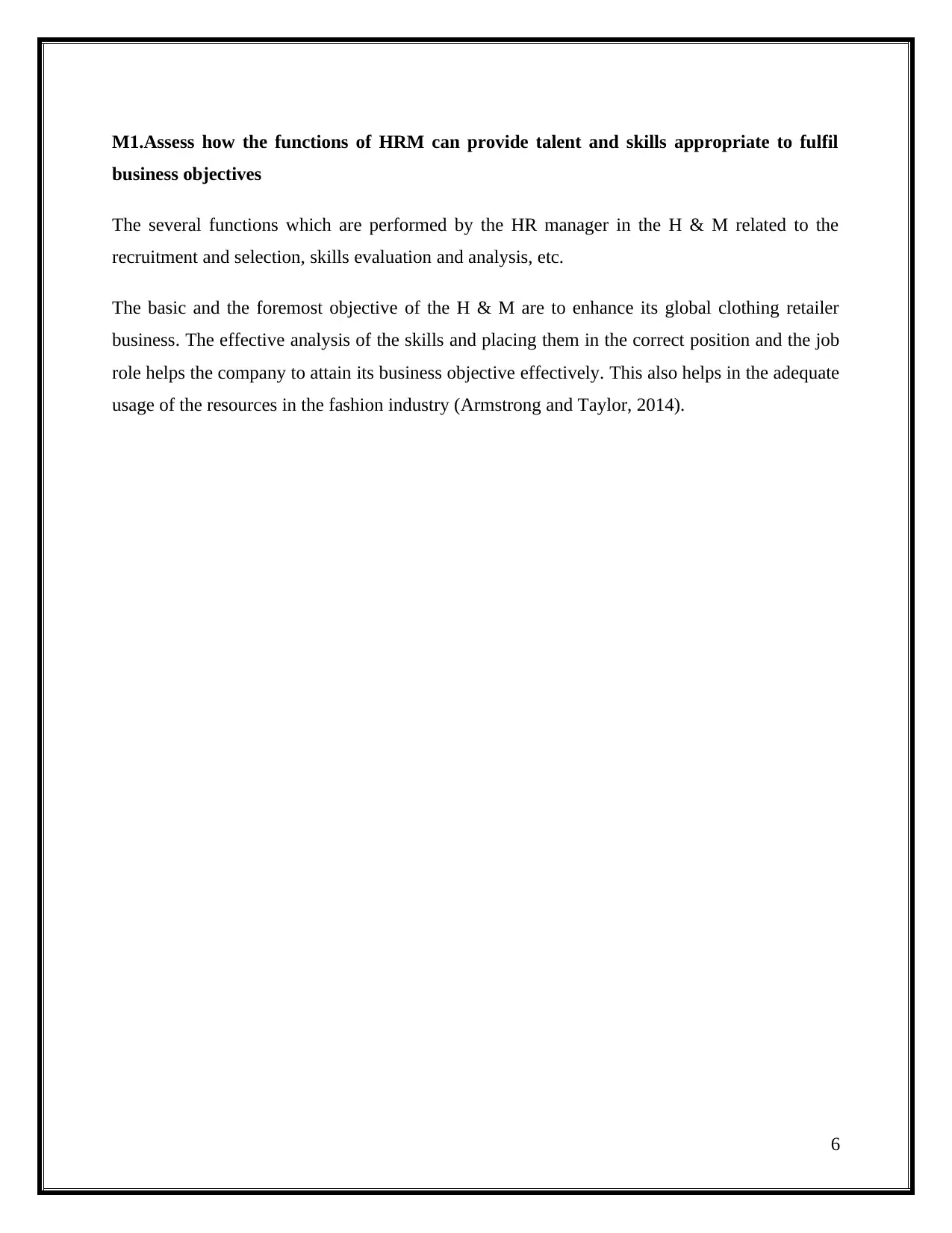
M1.Assess how the functions of HRM can provide talent and skills appropriate to fulfil
business objectives
The several functions which are performed by the HR manager in the H & M related to the
recruitment and selection, skills evaluation and analysis, etc.
The basic and the foremost objective of the H & M are to enhance its global clothing retailer
business. The effective analysis of the skills and placing them in the correct position and the job
role helps the company to attain its business objective effectively. This also helps in the adequate
usage of the resources in the fashion industry (Armstrong and Taylor, 2014).
6
business objectives
The several functions which are performed by the HR manager in the H & M related to the
recruitment and selection, skills evaluation and analysis, etc.
The basic and the foremost objective of the H & M are to enhance its global clothing retailer
business. The effective analysis of the skills and placing them in the correct position and the job
role helps the company to attain its business objective effectively. This also helps in the adequate
usage of the resources in the fashion industry (Armstrong and Taylor, 2014).
6
⊘ This is a preview!⊘
Do you want full access?
Subscribe today to unlock all pages.

Trusted by 1+ million students worldwide

D1 critically evaluate the strengths and weaknesses of different approaches to recruitment
and selection, supported by specific examples
There are used the internal and the external approach in the recruitment and selection. The
approaches used have certain advantages and the disadvantages.
H & M while adopting the internal approaches used in these processes get the benefit in the form
of the filing the vacancy related to the higher departments. While sometimes this approach leads
to involving certain conflicts among the workers present in the organisation. The options or the
choices available with the business are in very less number which develops the problems
(Breaugh, 2012).
In case of the external approaches used in the processes the weakness which the company bears
is its costs. For example when there is the appointment of the new employees in the H & M then
the adequate training sessions are organised and when they left then the loss will be bear by the
business. The strength of this approach is the involvement of the fresh talent in the business
which enhances its productivity.
7
and selection, supported by specific examples
There are used the internal and the external approach in the recruitment and selection. The
approaches used have certain advantages and the disadvantages.
H & M while adopting the internal approaches used in these processes get the benefit in the form
of the filing the vacancy related to the higher departments. While sometimes this approach leads
to involving certain conflicts among the workers present in the organisation. The options or the
choices available with the business are in very less number which develops the problems
(Breaugh, 2012).
In case of the external approaches used in the processes the weakness which the company bears
is its costs. For example when there is the appointment of the new employees in the H & M then
the adequate training sessions are organised and when they left then the loss will be bear by the
business. The strength of this approach is the involvement of the fresh talent in the business
which enhances its productivity.
7
Paraphrase This Document
Need a fresh take? Get an instant paraphrase of this document with our AI Paraphraser

P2 Explain the strengths and weaknesses of different approaches to recruitment and
selection
Recruitment and the selection are two procedures which are used in the business of H& M for
filing the job vacancy arrived. The effective approaches are used in such approaches. These
approaches are internal and the external approaches. The internal approaches are the one which
involves the selection of the employees among the inside environment of the business present.
The external approaches are the approaches which use the outside talent to select the individuals.
Strengths Weaknesses
Internal approaches The concept of the internal
approaches proves to be
successful in the business of H &
M when there is the arrival of
the vacancy on the higher posts.
The approach is best suitable to
develop the motivation and the
enthusiasm among the
employees.
This approach also helps in
saving the costs and the time as
there is no need to provide the
training to existing employees.
This approach however used in the
H & M involves certain
weaknesses. These are related to
the involvement of the conflicts in
the organisation among the
selection of the internal employees
only.
This also reduces the cooperation
among the employees which
develops the problems (DeVaro
and Morita, 2013).
External approaches The external approaches prove to
be beneficial in the working if
the business when the new talent
The weakness of this approach
which is faced by the H & M
provides more time and the costs of
8
selection
Recruitment and the selection are two procedures which are used in the business of H& M for
filing the job vacancy arrived. The effective approaches are used in such approaches. These
approaches are internal and the external approaches. The internal approaches are the one which
involves the selection of the employees among the inside environment of the business present.
The external approaches are the approaches which use the outside talent to select the individuals.
Strengths Weaknesses
Internal approaches The concept of the internal
approaches proves to be
successful in the business of H &
M when there is the arrival of
the vacancy on the higher posts.
The approach is best suitable to
develop the motivation and the
enthusiasm among the
employees.
This approach also helps in
saving the costs and the time as
there is no need to provide the
training to existing employees.
This approach however used in the
H & M involves certain
weaknesses. These are related to
the involvement of the conflicts in
the organisation among the
selection of the internal employees
only.
This also reduces the cooperation
among the employees which
develops the problems (DeVaro
and Morita, 2013).
External approaches The external approaches prove to
be beneficial in the working if
the business when the new talent
The weakness of this approach
which is faced by the H & M
provides more time and the costs of
8
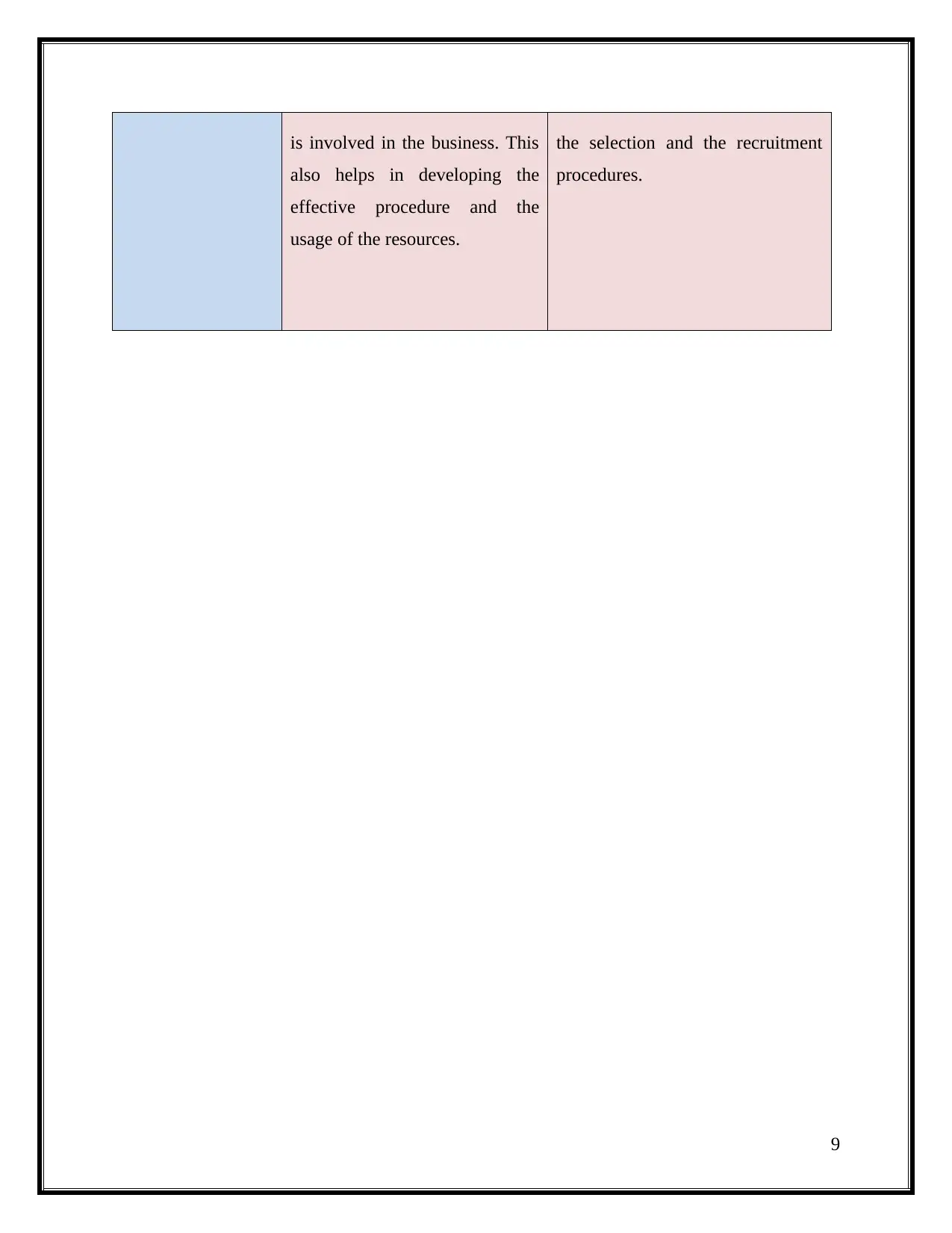
is involved in the business. This
also helps in developing the
effective procedure and the
usage of the resources.
the selection and the recruitment
procedures.
9
also helps in developing the
effective procedure and the
usage of the resources.
the selection and the recruitment
procedures.
9
⊘ This is a preview!⊘
Do you want full access?
Subscribe today to unlock all pages.

Trusted by 1+ million students worldwide
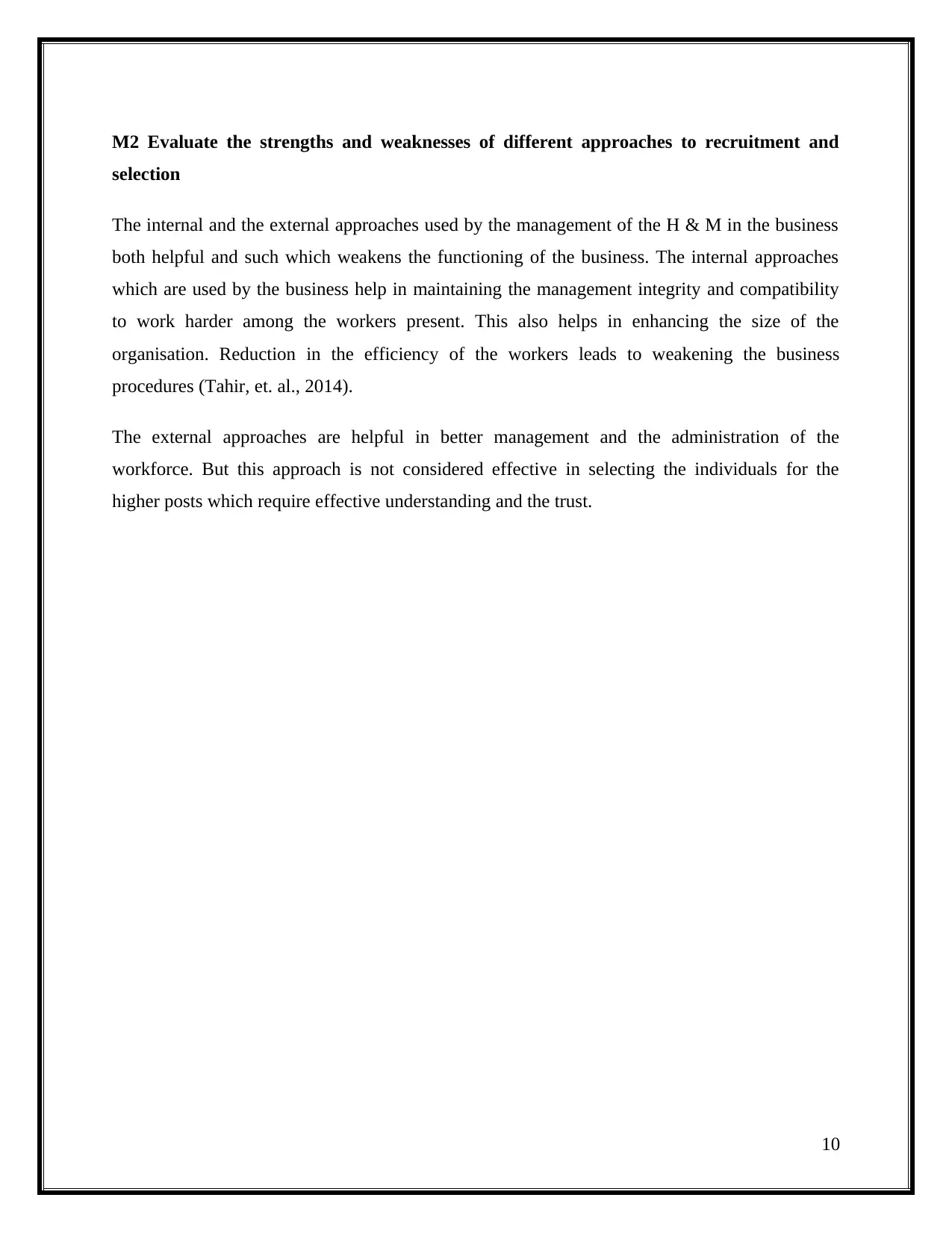
M2 Evaluate the strengths and weaknesses of different approaches to recruitment and
selection
The internal and the external approaches used by the management of the H & M in the business
both helpful and such which weakens the functioning of the business. The internal approaches
which are used by the business help in maintaining the management integrity and compatibility
to work harder among the workers present. This also helps in enhancing the size of the
organisation. Reduction in the efficiency of the workers leads to weakening the business
procedures (Tahir, et. al., 2014).
The external approaches are helpful in better management and the administration of the
workforce. But this approach is not considered effective in selecting the individuals for the
higher posts which require effective understanding and the trust.
10
selection
The internal and the external approaches used by the management of the H & M in the business
both helpful and such which weakens the functioning of the business. The internal approaches
which are used by the business help in maintaining the management integrity and compatibility
to work harder among the workers present. This also helps in enhancing the size of the
organisation. Reduction in the efficiency of the workers leads to weakening the business
procedures (Tahir, et. al., 2014).
The external approaches are helpful in better management and the administration of the
workforce. But this approach is not considered effective in selecting the individuals for the
higher posts which require effective understanding and the trust.
10
Paraphrase This Document
Need a fresh take? Get an instant paraphrase of this document with our AI Paraphraser

D2.Critically evaluate HRM practices and application within an organisational context
using a range of specific examples.
The several practices related to the HRM helps in the development of the certain advantages and
disadvantages in the business of H & M. for example the HRM practices of the organisation of
the training has an advantage in terms of enhancing the skills and disadvantage in the form of
increased costs and the time.
The practices related to the providing the reward to the employees helps in the business in terms
of the enhancing the motivation level of the employees while it develops the negativity among
the employees who are not rewarded (Armstrong and Taylor, 2014).
11
using a range of specific examples.
The several practices related to the HRM helps in the development of the certain advantages and
disadvantages in the business of H & M. for example the HRM practices of the organisation of
the training has an advantage in terms of enhancing the skills and disadvantage in the form of
increased costs and the time.
The practices related to the providing the reward to the employees helps in the business in terms
of the enhancing the motivation level of the employees while it develops the negativity among
the employees who are not rewarded (Armstrong and Taylor, 2014).
11
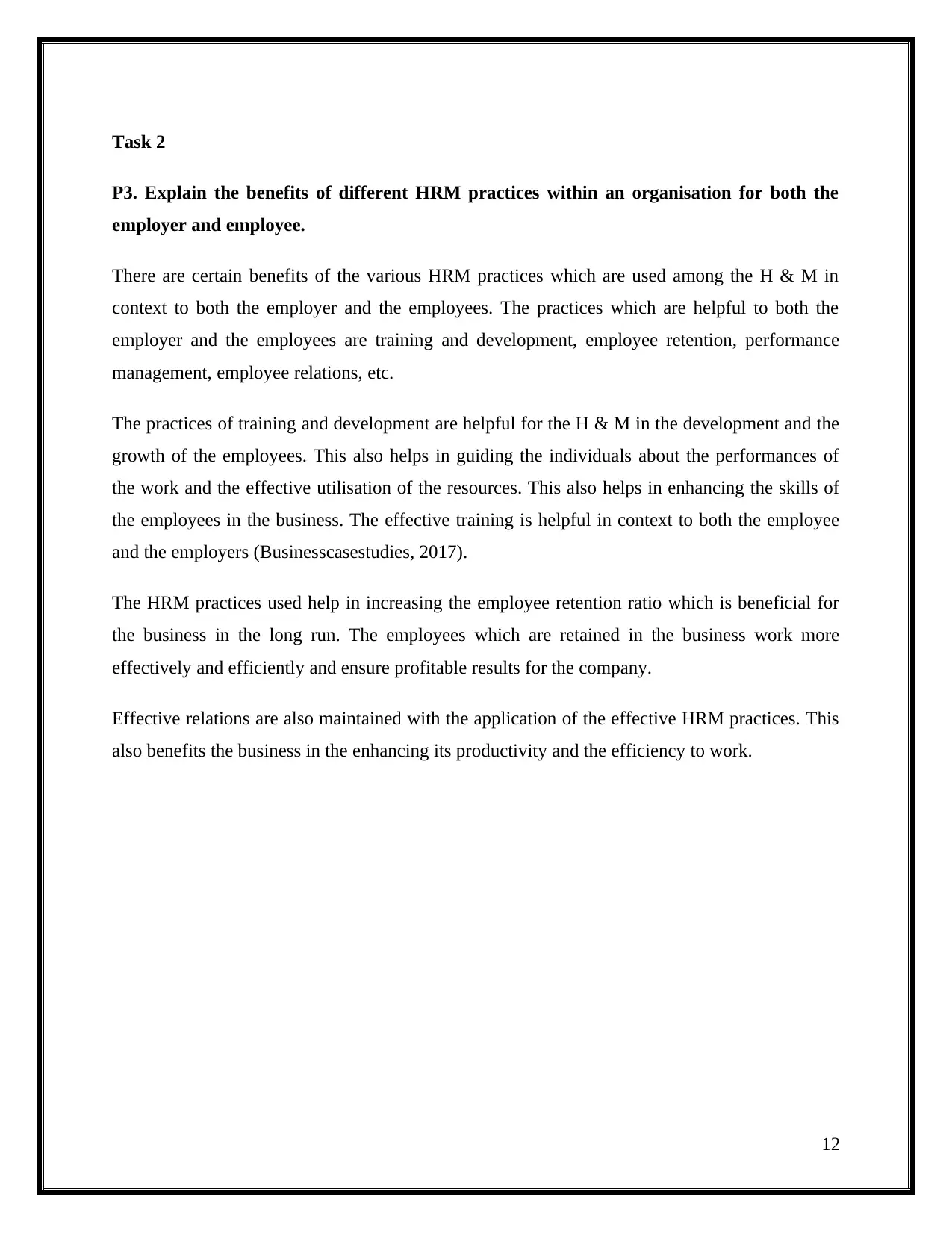
Task 2
P3. Explain the benefits of different HRM practices within an organisation for both the
employer and employee.
There are certain benefits of the various HRM practices which are used among the H & M in
context to both the employer and the employees. The practices which are helpful to both the
employer and the employees are training and development, employee retention, performance
management, employee relations, etc.
The practices of training and development are helpful for the H & M in the development and the
growth of the employees. This also helps in guiding the individuals about the performances of
the work and the effective utilisation of the resources. This also helps in enhancing the skills of
the employees in the business. The effective training is helpful in context to both the employee
and the employers (Businesscasestudies, 2017).
The HRM practices used help in increasing the employee retention ratio which is beneficial for
the business in the long run. The employees which are retained in the business work more
effectively and efficiently and ensure profitable results for the company.
Effective relations are also maintained with the application of the effective HRM practices. This
also benefits the business in the enhancing its productivity and the efficiency to work.
12
P3. Explain the benefits of different HRM practices within an organisation for both the
employer and employee.
There are certain benefits of the various HRM practices which are used among the H & M in
context to both the employer and the employees. The practices which are helpful to both the
employer and the employees are training and development, employee retention, performance
management, employee relations, etc.
The practices of training and development are helpful for the H & M in the development and the
growth of the employees. This also helps in guiding the individuals about the performances of
the work and the effective utilisation of the resources. This also helps in enhancing the skills of
the employees in the business. The effective training is helpful in context to both the employee
and the employers (Businesscasestudies, 2017).
The HRM practices used help in increasing the employee retention ratio which is beneficial for
the business in the long run. The employees which are retained in the business work more
effectively and efficiently and ensure profitable results for the company.
Effective relations are also maintained with the application of the effective HRM practices. This
also benefits the business in the enhancing its productivity and the efficiency to work.
12
⊘ This is a preview!⊘
Do you want full access?
Subscribe today to unlock all pages.

Trusted by 1+ million students worldwide
1 out of 23
Related Documents
Your All-in-One AI-Powered Toolkit for Academic Success.
+13062052269
info@desklib.com
Available 24*7 on WhatsApp / Email
![[object Object]](/_next/static/media/star-bottom.7253800d.svg)
Unlock your academic potential
Copyright © 2020–2025 A2Z Services. All Rights Reserved. Developed and managed by ZUCOL.



